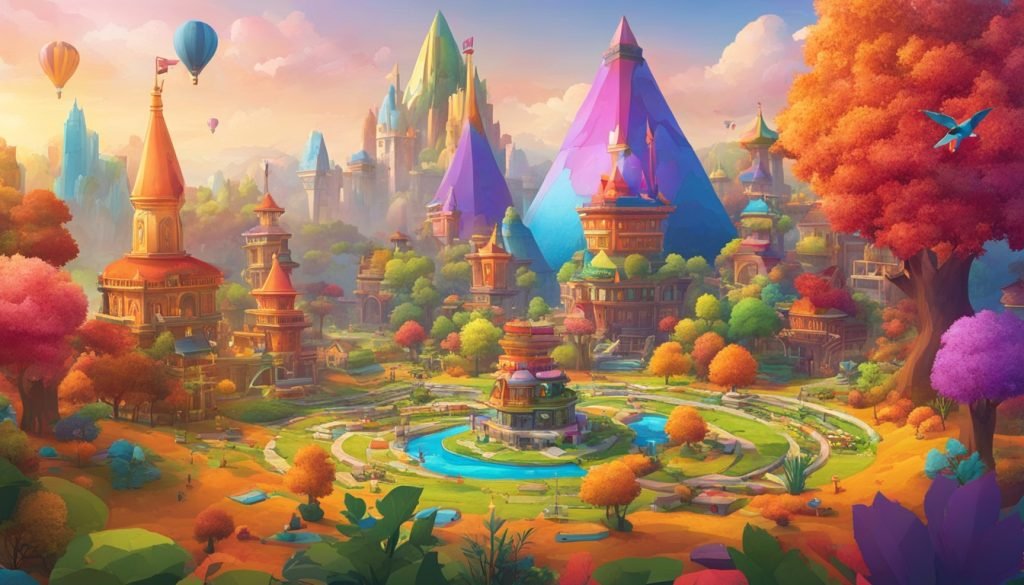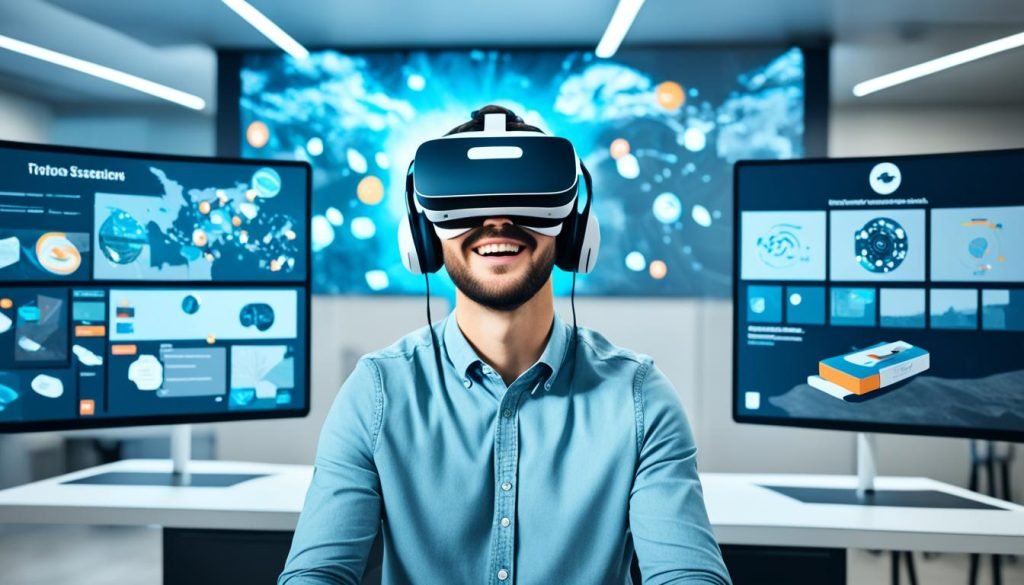The way we learn is changing fast, thanks to technology. By 2024, new trends in online learning will change how we grow in school and work. This article looks at how e-learning is becoming more personal, fun, and efficient.
We’ll see how Artificial Intelligence (AI) and hybrid learning are changing education. These changes are important for teachers, students, and schools to keep up with the digital world.
Key Takeaways
- The integration of Artificial Intelligence is enhancing personalized learning experiences.
- There is a growing demand for hybrid learning environments that combine in-person and online education.
- Gamification is increasingly being used to motivate students through interactive and engaging content.
- Immersive technologies like VR and AR are making learning more experiential and memorable.
- Adapting to online learning trends is essential for effective teaching and learning.
Artificial Intelligence (AI) Revolutionizing Education
Artificial intelligence is changing how we learn. It meets the unique needs of each student, making learning more personal. Now, students can interact with materials that fit their interests and knowledge levels. This leads to better engagement and success in school.
Personalized Learning Experiences
AI helps educational platforms understand how students learn best. It creates learning paths just for them. Key parts of personalized learning include:
- Adaptive assessments that change based on what students answer
- Curated content that matches what students like and are good at
- Real-time feedback to help students adjust their learning
Efficiency Boosts for Educators
Using AI in education helps teachers work more efficiently. It takes over routine tasks, freeing up time for teaching. The benefits are clear:
| Task | Traditional Method | AI Method |
|---|---|---|
| Grading | Manual grading of assignments | Automated grading systems |
| Student Tracking | Monitoring student progress one by one | AI-driven analytics for tracking in real-time |
| Curriculum Development | Curriculum that doesn’t change much | Dynamic curricula based on learning data |
Online Learning Trends Shaping the Future
The way we learn is changing fast. Schools are now adapting to what students want. They’re mixing traditional classes with online learning. This mix makes learning easier for everyone.
Growing Demand for Hybrid Learning
More students want to learn in a mix of ways. They like the flexibility of online classes. This lets them keep up with school and personal life.
Students say this mix of in-person and online classes works best for them. It makes learning easier and more effective.
| Aspect | Traditional Learning | Hybrid Learning |
|---|---|---|
| Flexibility | Limited | High |
| Student Engagement | Medium | High |
| Accessibility | Low | High |
| Learning Pace | Fixed | Self-paced |
This table shows how hybrid learning is better for today’s students. It’s important for educators to know this. They can then create better learning plans for us.
The Rise of Gamification in E-Learning
Gamification in education is becoming more popular. It adds game-like elements to learning. This makes learning more fun and engaging.
It turns boring lessons into exciting activities. This approach gets students more involved and interested. It also helps them do better in school.
Motivating Students through Interactive Learning
Interactive learning platforms are key in this change. They make learning fun and interactive. Students can dive deeper into the material.
Using points, leaderboards, and challenges creates a friendly competition. This motivates students to do their best. It makes learning more enjoyable and active.
Performance Enhancements through Game Elements
Game elements boost performance in many ways. They provide instant feedback on how well students are doing. This helps students see where they need to improve quickly.
Studies show that using gamification can greatly improve performance. It helps both individual students and the whole class stay engaged.

Immersive Technologies: Virtual and Augmented Reality (VR/AR)
Immersive technologies like virtual reality and augmented reality are changing how students learn. They offer interactive environments that make learning more effective. These technologies are different from old ways of learning.

Studies show that using immersive learning can boost learning by up to 76%. This shows how powerful VR and AR can be in making hard subjects easier to understand for everyone.
- Virtual reality lets students explore ancient civilizations in a 3D world.
- Augmented reality adds digital info to the real world, helping with experiments or history.
- Both VR and AR suit different learning styles, making learning more fun and personal.
When schools use VR and AR, students get a better learning experience. These tools help students get ready for real-life challenges. They also help students think more creatively and solve problems better.
| Technology | Benefits | Application Examples |
|---|---|---|
| Virtual Reality | Fully immersive experiences | Simulations in science labs, virtual field trips |
| Augmented Reality | Enhances interaction with real world | Interactive textbooks, AR-enabled learning apps |
Conclusion
The educational world is changing fast, thanks to new tech and the needs of today’s learners. We’re seeing a big move towards learning that’s tailored to each student. This makes education more welcoming and fun for everyone.
Now, we’re also seeing the power of games and virtual worlds in the classroom. These tools make learning exciting and help students do better. They show how technology can make learning more effective by tracking progress and giving feedback right away.
The mix of old and new learning methods is becoming more popular. It combines the best of both worlds to give students a full learning experience. For teachers and schools, keeping up with these changes is key. They need to meet the changing needs of their students in today’s fast-paced education world.



